MARIANI’SVirtual
Gourmet
December
15, 2013
NEWSLETTER

"Making
Waffles" by Jacob de Beuckalaer
THIS
WEEK
ADIRONDACK
REVERIE:
WHITEFACE LODGE
by Edward Brivio
NEW
YORK CORNER
Clement
by John Mariani
Carmignano
Gets Its Due from Capezzana
by John Mariani
ADIRONDACK REVERIE:
WHITE FACE LODGE

by
Edward Brivio
Photos by Robert
Pirillo
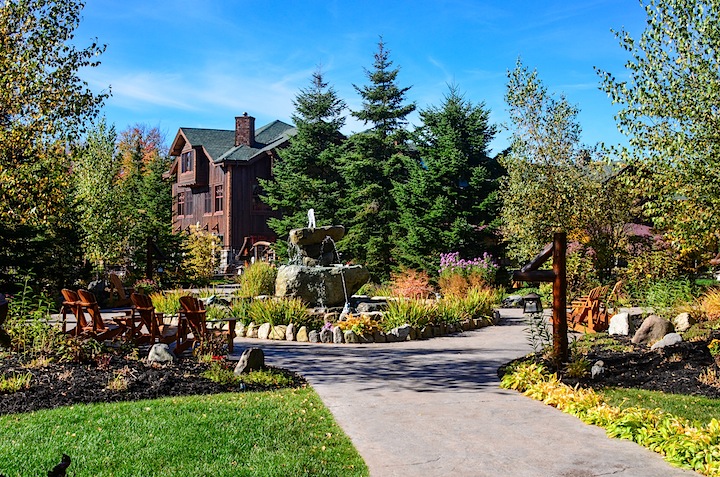 Nestled
near the southwest corner of Lake Placid, only minutes
from the town of Lake Placid, the Whiteface
Lodge brings a new level of luxury
to the High Peaks region of the Adirondacks.
Constructed in the style of the Great Camps
built by the late 19th and early 20th century "robber
barons" for which the region is famous, it combines
rustic charm and strikingly beautiful log cabin design
with all the amenities of a world-class resort. No
need to be fabulously wealthy or own your own Pullman
car to have access to the last word in rural comfort
on the threshold of this great wilderness of
mountains, lakes, and pristine forests covering some 6
million acres. Traditional Adirondack Rustic building
methods and materials -- log framing, local wood and
fieldstone -- coupled with Adirondack-style,
handcrafted furniture, furnishings, and decorative
details capture the rugged natural beauty of the
lodge's surroundings.
Nestled
near the southwest corner of Lake Placid, only minutes
from the town of Lake Placid, the Whiteface
Lodge brings a new level of luxury
to the High Peaks region of the Adirondacks.
Constructed in the style of the Great Camps
built by the late 19th and early 20th century "robber
barons" for which the region is famous, it combines
rustic charm and strikingly beautiful log cabin design
with all the amenities of a world-class resort. No
need to be fabulously wealthy or own your own Pullman
car to have access to the last word in rural comfort
on the threshold of this great wilderness of
mountains, lakes, and pristine forests covering some 6
million acres. Traditional Adirondack Rustic building
methods and materials -- log framing, local wood and
fieldstone -- coupled with Adirondack-style,
handcrafted furniture, furnishings, and decorative
details capture the rugged natural beauty of the
lodge's surroundings.
Everywhere the eye looks, some
perfectly wrought detail brings the world outside the
timbered windows, both flora and fauna, inside:
handcrafted ironwork, used for wall sconces and hammered
into vines around the chandeliers; cast iron statuettes
of bears, stags, and ducks here and there; the
occasional full size Old Town canoe, and antlers
everywhere, even a large many-antlered chandelier, along
with a handful of taxidermy animals, all bear this
regional stamp. Hunting and fishing memorabilia abound.
Subdued lighting gives the warm, firelit glow of a snug
cabin in the deep backwoods to the dark, exposed timbers
of the interior.
Our guest room would have done very
nicely as a freestanding, full-sized house. Occupying
two top floors and 1,800 square feet were a large living
room, a dining room, a full kitchen with stainless
appliances and granite countertops, three bedrooms,
including an over-sized master bedroom on the second
floor, next to a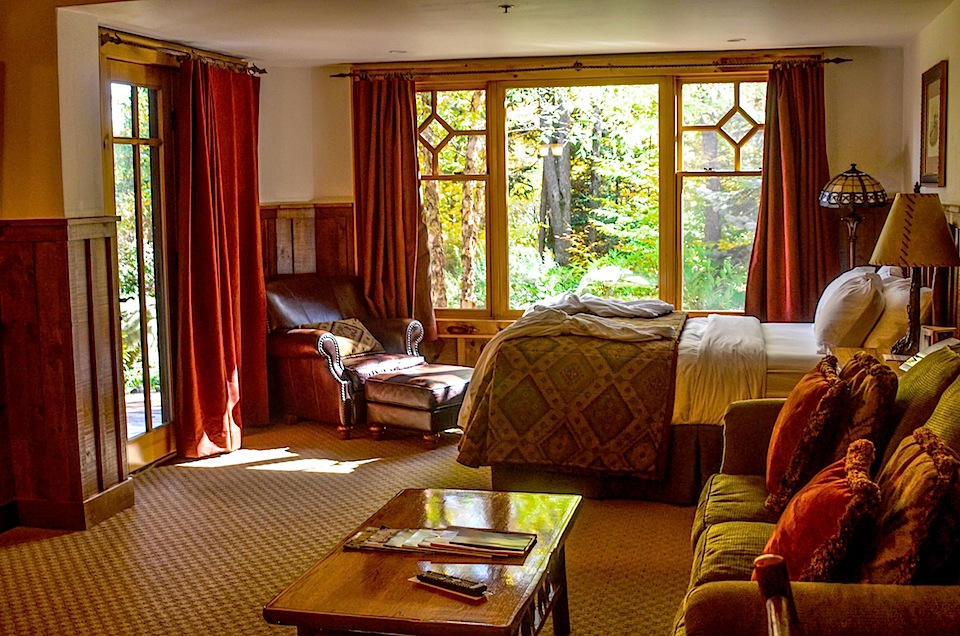 very spacious bathroom with
jetted bathtub, separate shower, a vanity with two
sinks, and heated floors. And how convenient were the 2
gas fireplaces, one in the living room and the other in
the bedroom, turned on with a simple press of a button,
providing not only real flickering flames to gaze at,
but a gentle, cozy warmth as well. Beautiful,
handcrafted Adirondack-style furniture and accessories
filled the space. A private cedar and mahogany balcony
off the living room let us relax in the fall air to
enjoy the view of Whiteface Mountain in the near
distance and the polychrome leaves ablaze on the
surrounding slopes.
very spacious bathroom with
jetted bathtub, separate shower, a vanity with two
sinks, and heated floors. And how convenient were the 2
gas fireplaces, one in the living room and the other in
the bedroom, turned on with a simple press of a button,
providing not only real flickering flames to gaze at,
but a gentle, cozy warmth as well. Beautiful,
handcrafted Adirondack-style furniture and accessories
filled the space. A private cedar and mahogany balcony
off the living room let us relax in the fall air to
enjoy the view of Whiteface Mountain in the near
distance and the polychrome leaves ablaze on the
surrounding slopes.
The most impressive, truly
breathtaking space here is the dining room of the
lodge's signature restaurant, Kanu. Massive
timber uprights and large log trusses frame a
three-story Great Room, with log walls, a timbered
loggia, and two granite, wood-burning fireplaces, each
big enough for a manor house. Two large wrought iron
chandeliers and an even more interesting glass one in an
Arts and Craft style finished off with antlers hung by
iron chains from the soaring 30-foot-high ceiling, with
a skylight at its apex. It’s the perfect backdrop for
the large moose and elk heads mounted above the
fireplaces, a canoe suspended from the back wall with a
toy stuffed bear as a passenger, and beautifully made
hewn-log tables and chairs. This is "roughing it" in
grand style.
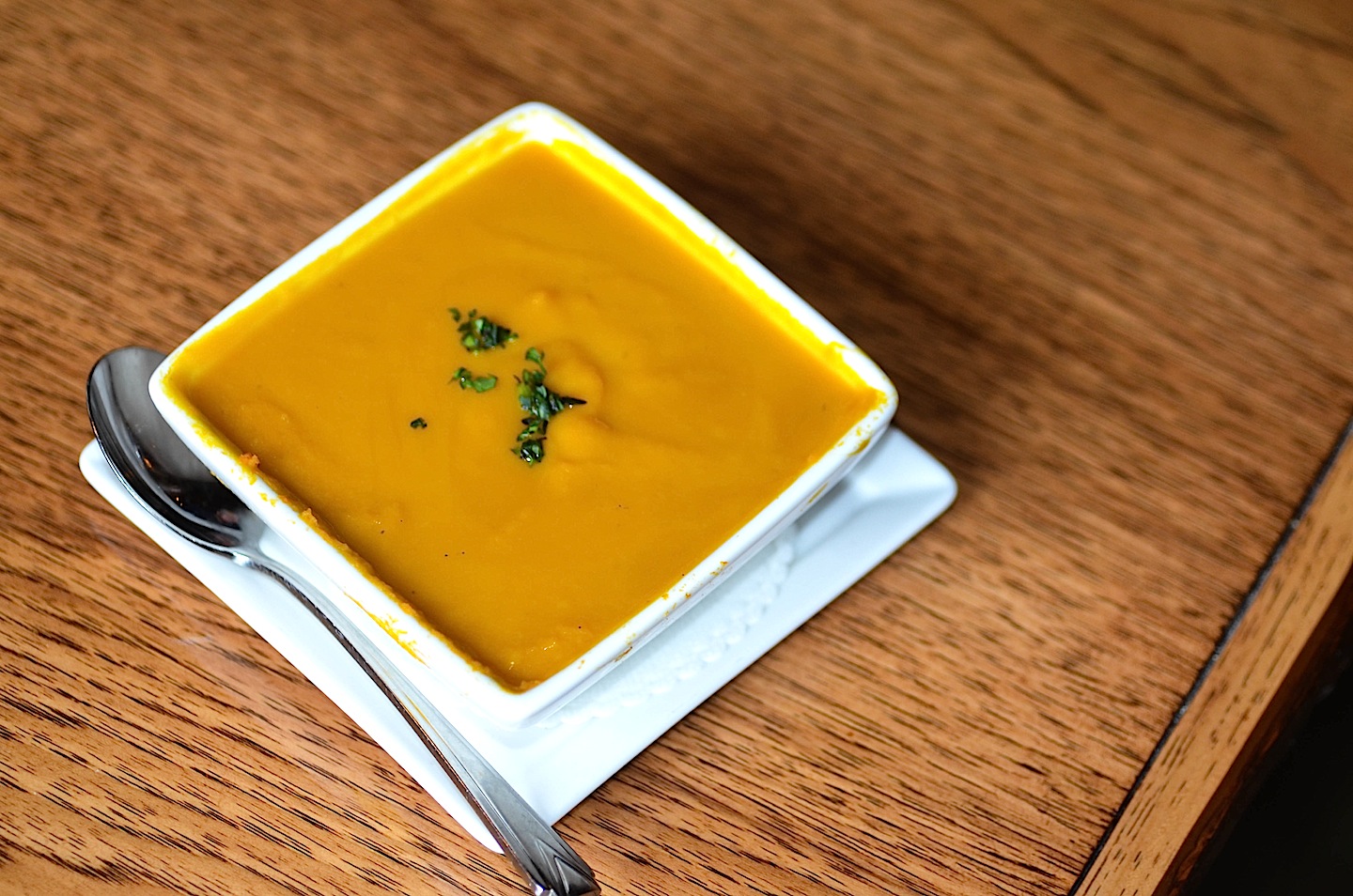 Kanu was the venue for a Fall
Festival Dinner for 40 or so lucky diners the weekend I
visited. The evening started quietly with a hay-smoked
Nova Scotia oyster as amuse bouche,
very lightly smoked and very fresh. I'm not sure if
using greens as a first course was a good idea. For me,
the Fledgling Crow Farms Autumn greens, grown just down
the road in Keeseville, with Old Chatham Ewe's Bleu
Cheese, excellent as they were, would have been more
welcome as a sort of intermezzo
after one or two more substantial dishes.
Kanu was the venue for a Fall
Festival Dinner for 40 or so lucky diners the weekend I
visited. The evening started quietly with a hay-smoked
Nova Scotia oyster as amuse bouche,
very lightly smoked and very fresh. I'm not sure if
using greens as a first course was a good idea. For me,
the Fledgling Crow Farms Autumn greens, grown just down
the road in Keeseville, with Old Chatham Ewe's Bleu
Cheese, excellent as they were, would have been more
welcome as a sort of intermezzo
after one or two more substantial dishes.
Local sourcing was the night's theme,
as was the use of seasonal ingredients. Things got much
more interesting with the next dish, Juniper Hill Farm
(in Wadhams) butternut squash puree (left), a pretty,
tasty orange smear on the plate, made even better with
delicious chanterelles, toasted squash seeds, and
crunchy, flavorful brioche croutons.
Harmony Hill Farmstead Scotch
egg, from a farm in Malone, was a great idea. I always
thought that a Scotch Egg, which is standard pub fare in
England, prepared with care and topnotch ingredients
would be delicious. With Vermont Maple sausage
surrounding the hard-boiled egg, it was pretty much a
novelty for everyone at the table, but was definitely
enjoyed by all.
The main course was again something
of a surprise. The chefs requested Kilcoyne Farm,
located far north near the Canadian border in Brasher
Fall, to butcher their beef so the tenderloin was still
on the bone, something one rarely sees. The bone gave
the melt-in-your-mouth cut exceptional flavor, while the
Swiss chard, baby carrots, and celeriac were the perfect
seasonal touch.
New York State Lady Apple sorbet with
local maple syrup and a yogurt pound cake brought things
to a delicious, gentle close. The evening was a well
thought out, successfully executed, multi-course Fall
Festival Dinner, with perfectly sized portions, and, for
the most part, showcasing the bounty of the season.
Well-trained wait staff ensured there were no long waits
between courses, so everything moved along smartly. The
perfectly light, yet satisfying, dessert also managed to
cleanse the palate.
On another evening we ordered from
Kanu's regular menu, starting smartly with a wild
mushroom risotto, perfectly executed, creamy, with a
slight crunch to the rice kernels, and all but
bursting with flavor from the assorted mushrooms.
Serving it in a wrought iron pan made sure it was hot
right up to the last, sad bite. Another good starter was
Smoked Mountain trout (not local) with arugula, radish
and dollops of trout roe. The only misstep was the crème
fraîche foam--a nod to molecular
cuisine--that was just too unsubstantial to play any
real role in the dish. Here was a refinement that
out-smarted itself. A side order of regular crème
fraîche, requested from the waiter,
performed much better.
rice kernels, and all but
bursting with flavor from the assorted mushrooms.
Serving it in a wrought iron pan made sure it was hot
right up to the last, sad bite. Another good starter was
Smoked Mountain trout (not local) with arugula, radish
and dollops of trout roe. The only misstep was the crème
fraîche foam--a nod to molecular
cuisine--that was just too unsubstantial to play any
real role in the dish. Here was a refinement that
out-smarted itself. A side order of regular crème
fraîche, requested from the waiter,
performed much better.
A Niman Ranch heritage pork chop with
roasted Brussels sprouts and applewood smoked bacon was
expertly prepared so the grilled chop was medium
throughout but not dried out, something I've never been
able to accomplish at home. Pastrami-style brined
organic salmon, with wild rice, toasted almonds and
acorn squash not only tasted good but looked good as
well, the brick-colored fillet laying atop a
green-skinned round of squash, whose center was filled
with wild rice, pearl onion confit, and toasted almonds.
The only real culinary disappointment
of the trip was the Whiteface Cheddar burger served at
the Kanu Lounge,
right across the floor from the main dining room. I'd
been eyeing them for days, as the diners seemed to be
thoroughly enjoying theirs. It looked well-grilled,
juicy and delicious. Unfortunately, mine was bland,
over-cooked, and, worst of all, rather dry. The brioche
bun, honey-cured bacon, and french fries did help
somewhat. Also, do order the yummy truffle fries
available as a side dish, a partnership surely made in
heaven.
Sautéed brook trout, on the
other hand, was an unqualified success, with Thousand
Island wild rice and roasted root vegetables. Our first
courses were sesame-seared ahi tuna with wonderful
wasabi crème
fraîche, and a curried carrot soup that
stole the show, definitely "worth a detour" all on its
own. Executive Chef Davis S. Haick and the chef de
cuisine, Greg Barth, take full advantage of their neck
of the woods. Their contemporary take on a distinctly
American haute
cuisine showcases the best seasonal ingredients,
locally sourced as much as possible. Somebody took time
and really did their homework in ferreting out all these
local 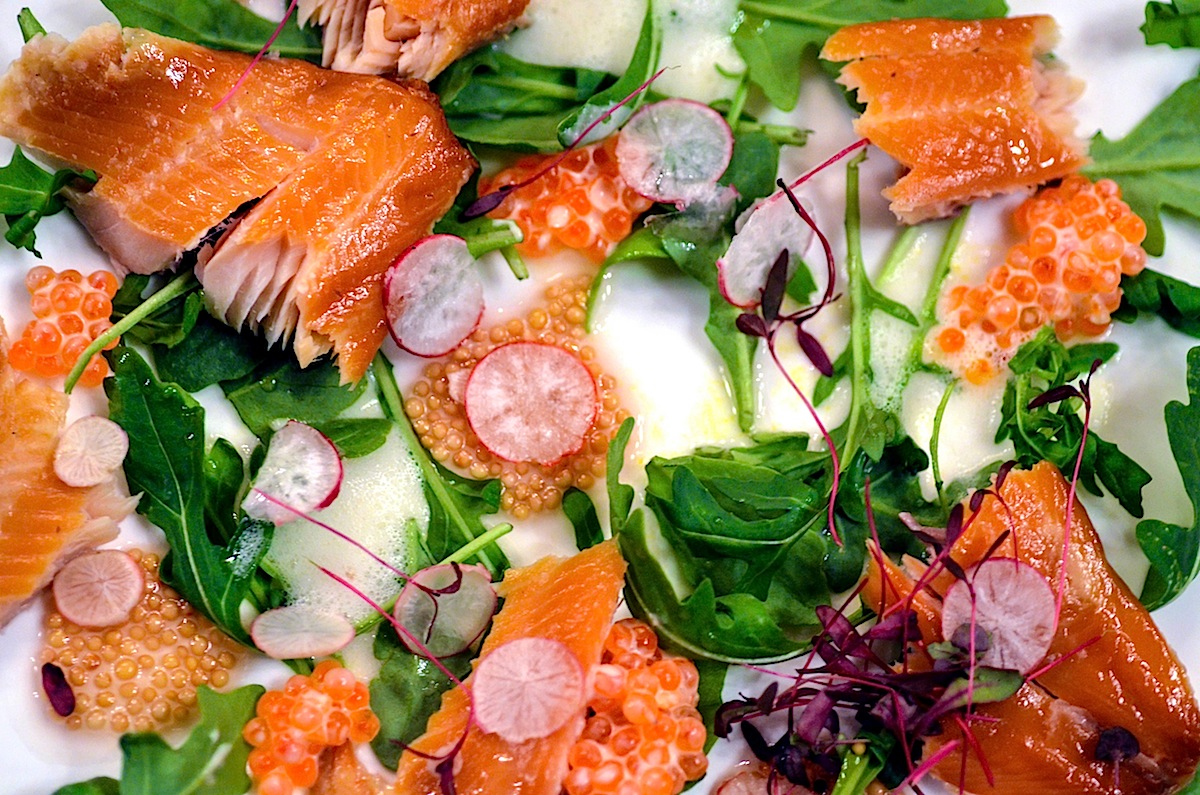 purveyors. The chefs do their best never
to betray the season. They don't over think their
dishes, or cram plates with as many different things as
possible. The sides highlight the main ingredient, they
don't intimidate it.
purveyors. The chefs do their best never
to betray the season. They don't over think their
dishes, or cram plates with as many different things as
possible. The sides highlight the main ingredient, they
don't intimidate it.
The Adirondack Rustic
décor, done with impeccable taste, does have its
touches of whimsy. I especially liked the stuffed
raccoon, upright and scratching his claws on a stump,
that sits right up against the bottom post of the flight
of stairs leading to the main floor. I failed to notice
it at first. With my hand trailing on the stair railing
as I came down, it suddenly and unexpectedly encountered
some furry critter when I reached the bottom. I didn't
realize at first that this was taxidermy, and not some
live forest fauna foraging in the lobby.
Kanu: starters: $12-15, main courses: $28-40, desserts: $10; Kanu Lounge: starters: $9-13, soups and salads: $8-12, sandwiches: $15-18, and entrees $20-25.
❖❖❖
NEW YORK CORNER
by John Mariani
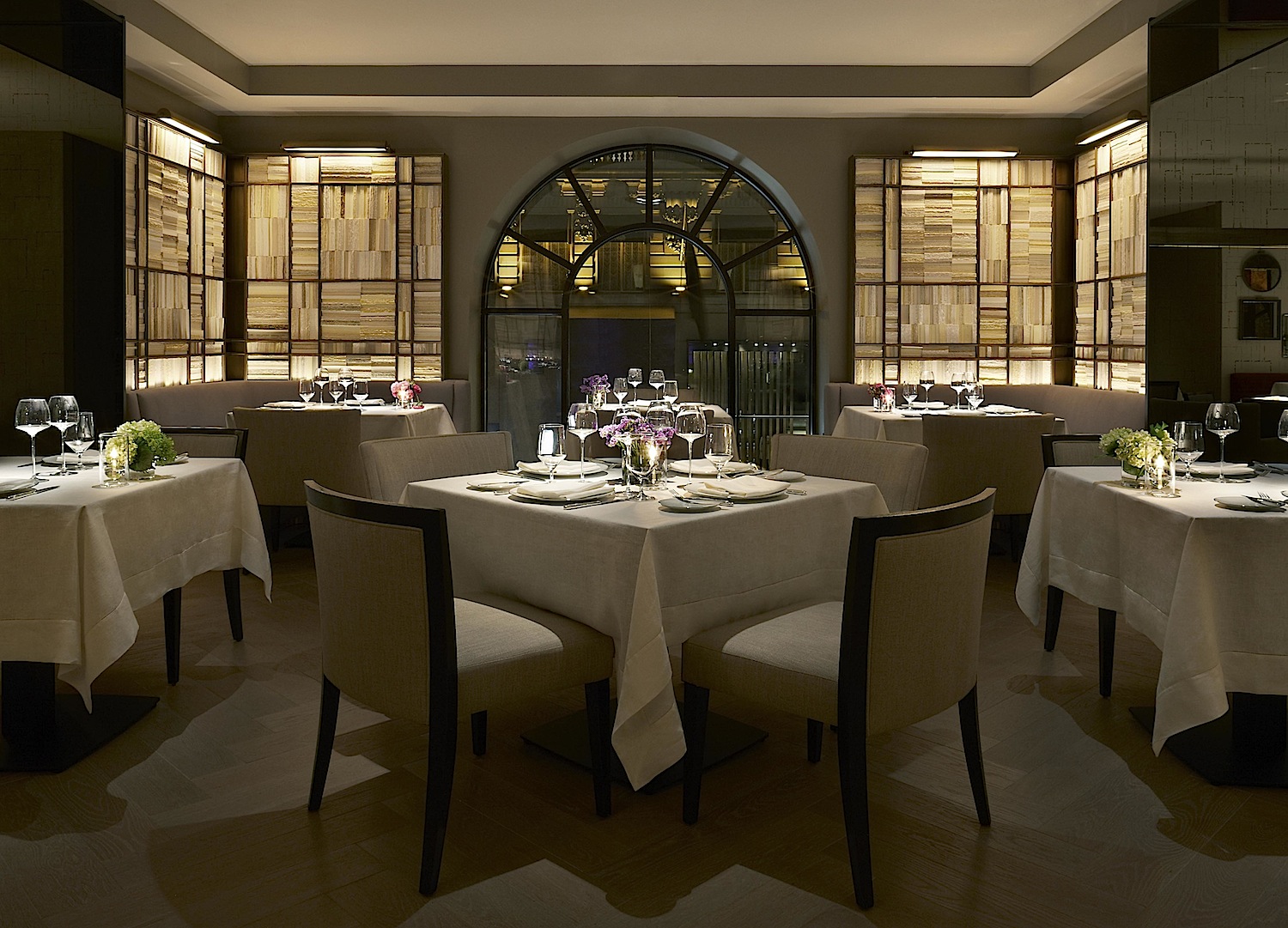 Clement
Clement
The Peninsula Hotel
700 Fifth Avenue (at 55th Street)
212-956-2888
peninsula.com
Clement
is
easily the most handsome restaurant to open in NYC this
year, which, at a time when the food media seem to
prefer to dine in places that haven't even the appeal of
a diner, may be an difficult draw. Clement is an adult
restaurant, not given to rumpus room décor,
eardrum-shattering music or t-shirted, tattooed servers
whose one-word answer to everything is "awesome."
Set up a flight of stairs at the
Peninsula Hotel off Fifth Avenue, Clement is a series of
very comfortable, beautifully lighted dining rooms and
sophisticated bar where the tables are set a commodious
distance from one another and draped in good linens,
with fine silverware and wine glasses. There are pottery
installations at reception by the artist Pascale
Giradin; the Book Room (above) is treated with textured paper
stacked along the corner walls by the artist Moss+Lam;
the Mirror Room’s artwork works intriguing magic, while
the Color Room, with its sixty-foot-long, hand-etched
urban “jungle,” is uniquely New York.
Practice and experience also imbue
the service staff, which is ultra-attentive, though
sometimes intrusive, ardently reciting everything  from the
smallest ingredient in a special cocktail to every item
that goes onto a plate, however incidental it might be
or already explained on the menu. Bar
manager Rich Lilley is, however, as knowledgeable as
they come and should be consulted on cocktails and wine.
from the
smallest ingredient in a special cocktail to every item
that goes onto a plate, however incidental it might be
or already explained on the menu. Bar
manager Rich Lilley is, however, as knowledgeable as
they come and should be consulted on cocktails and wine.
That said, if you have all the time
in the world, you can bask in the louche pace of a meal
at Clement and concentrate on chef Brandon Kita’s
eclectic menu and beautifully composed cuisine, which
can also be complicated, when a few less ingredients on
the plate would add up to more distinct
flavors. Our party of four tasted
widely, guided by the chef and sommelier. We began with
Long Island oysters with plum, olive oil, sea salt, and
a dish of fluke with a citrus dashi, avocado
and sorrel juice. A “taste of fall” (right) was composed
of Woodlands ham, seasonal offerings and dressed with a
hazelnut vinaigrette.
A very fine foie gras
terrine took on just the right sweet-sour balance from
blueberries and texture from pistachios and toasted
brioche, while scallops from Barnegat Light, NJ (Pop
Culture Trivia Question: What Four Seasons song mentions
Barnegat Bay?), were caressed with truffle, cauliflower
and sheer lardo.
These starters were accompanied by a lightly
acidic Austrian Weingut Knoll 2009 Riesling Smaragd
“Ried Loibenberg.”
Ravioli had a hit of
black pepper and parmesan, which didn’t work with the
added caviar, which might have been better with a main course of
salmon in a fennel brandade with cucumber coulis
and dill. Lobster was enriched by kabocha squash and
chanterelle mushroom, while black sea bass came in an
appealing, if unexpected, Peking duck broth with fall
mushrooms and spinach. With these we enjoyed a
delicious Domaine Harmand-Geoffroy 2008
Gevrey-Chambertin “Vieilles Vignes.”
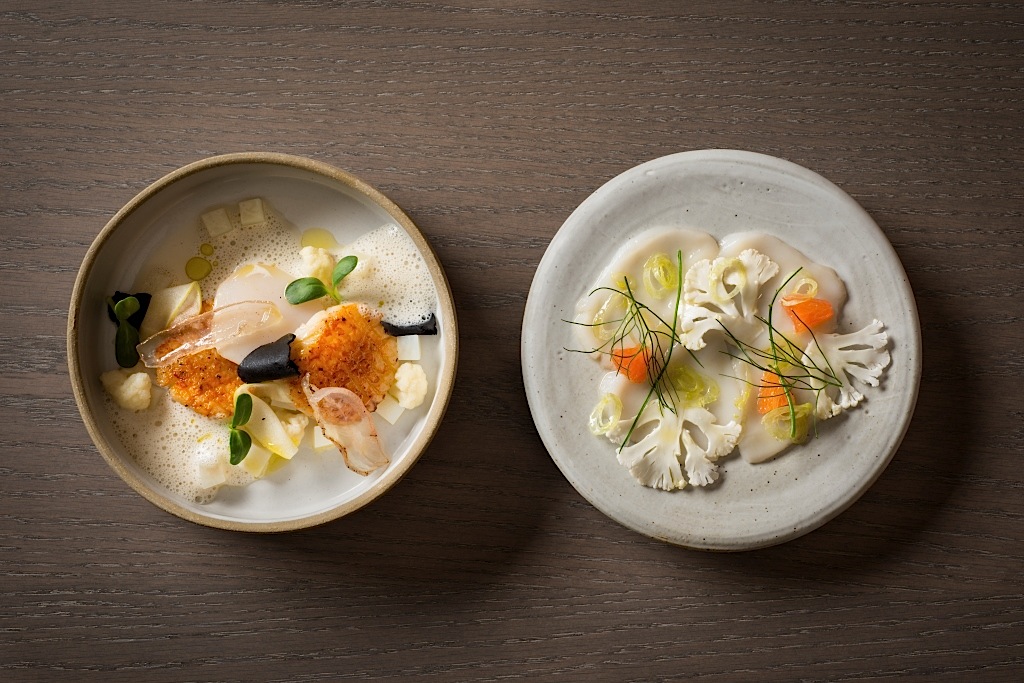 The
meat
dishes chosen by the chef were accompanied by a
lustrous Clos Mogador 2010 Priorat. Long Island
duck took on the traditional flavors of orange peel with
the novelty of it being smoked, along with flowering
chive and a sweet roasted pear. Excellent lamb was
well served by simple additions of potato, kale and
roasted eggplant, while a juicy beef tenderloin had
potato purée, roasted carrot and a touch of star
anise. Most enjoyable was the baby pig with crisp
apples, parsnip and cabbage, which in NYC’s cold weather
is a very enticing option.
The
meat
dishes chosen by the chef were accompanied by a
lustrous Clos Mogador 2010 Priorat. Long Island
duck took on the traditional flavors of orange peel with
the novelty of it being smoked, along with flowering
chive and a sweet roasted pear. Excellent lamb was
well served by simple additions of potato, kale and
roasted eggplant, while a juicy beef tenderloin had
potato purée, roasted carrot and a touch of star
anise. Most enjoyable was the baby pig with crisp
apples, parsnip and cabbage, which in NYC’s cold weather
is a very enticing option.
Desserts were imaginative but
restrained in the best sense--chocolate banana cake with
rum butter ice cream; apple crisp with cranberry pecan
crumble and orange buttermilk ice cream; and sea salt
caramel chocolate with passion fruit crémeux and
thyme ice cream.
Clement adds measurably to a breed of
sophisticated restaurants New Yorkers still admire and
pay attention to, even if The New Yorker
food writers rarely seem to eat this side of the
Brooklyn Bridge any more. Clement’s beauty,
civilized level of conversation, and attentive staff
make it all the more attractive right now around the
holidays. The fact that it’s open for breakfast means
you can also stay over and wake up in anticipation of
still more refinement.
❖❖❖
NOTES FROM THE WINE CELLAR
Carmignano Gets Its Due from Capezzana
by John Mariani

The Contini Bonacossi of
Tenuta di Capezzana
Forgive the pun, but in Tuscany there
is more ferment going on than anywhere else in Italy
right now. Driven by critical praise for its
highest quality wines like Brunello di Montalcino and
the so-called “Super Tuscans” like Solaia, Sassicaia and
others, Tuscany’s wines also float on the region’s
aristocratic reputations of estate owners like Incisa
della Rocchetta, Piero Antinori, and Frescobaldi—all
marquis—and Baron Ricasoli.
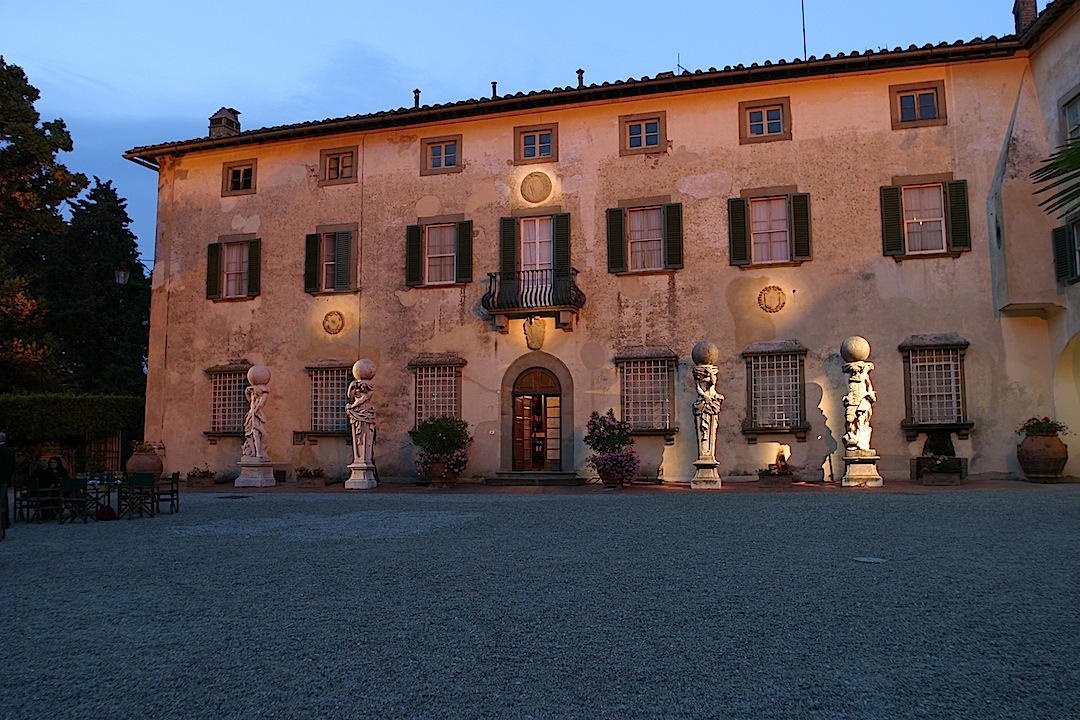 Their money (the
Antinoris are a banking family) and innovative spirit
radically changed Tuscany’s image as being awash in
cheap Chianti to that of Italy’s premier wine region,
all built on the native sangiovese grape.
Their money (the
Antinoris are a banking family) and innovative spirit
radically changed Tuscany’s image as being awash in
cheap Chianti to that of Italy’s premier wine region,
all built on the native sangiovese grape.
One of Tuscany’s great
sangiovese-based wines that has not yet gotten its due
is carmignano, a blend of at least 50 percent
sangiovese, up to 20 percent cabernet sauvignon, plus 20
percent caniolo nero and five percent mammolo and/or
colorino. Though not as powerful as its Tuscan cousins
whose grapes come from lower altitudes, carmignano has
firm tannins, slightly lower acidity and a great deal of
herbaceous aromas.
The family intent on changing
carmignano’s reputation is indeed blue blooded: in the
1920s Count Alessandro Contini Bonacossi purchased the
Capezzana estate and soon started putting its wines in
Bordeaux-style bottles, rather than the straw-covered
flasks of the past.
His nephew Ugo led the fight in
the 1960s to have carmignano classified as a denominazione d’origine
controllata wine under Italian law, then in
1990 as the highest appellation, denominazione d’origine
controllata e guarantita. Today, Tenuta di
Capezzana accounts for 70 percent of the DOCG wines
produced in the area.
Capezzana (above)has also been
testing out biodynamic viticulture and by 2015 expects
their vineyards to be certified 100 percent organic. 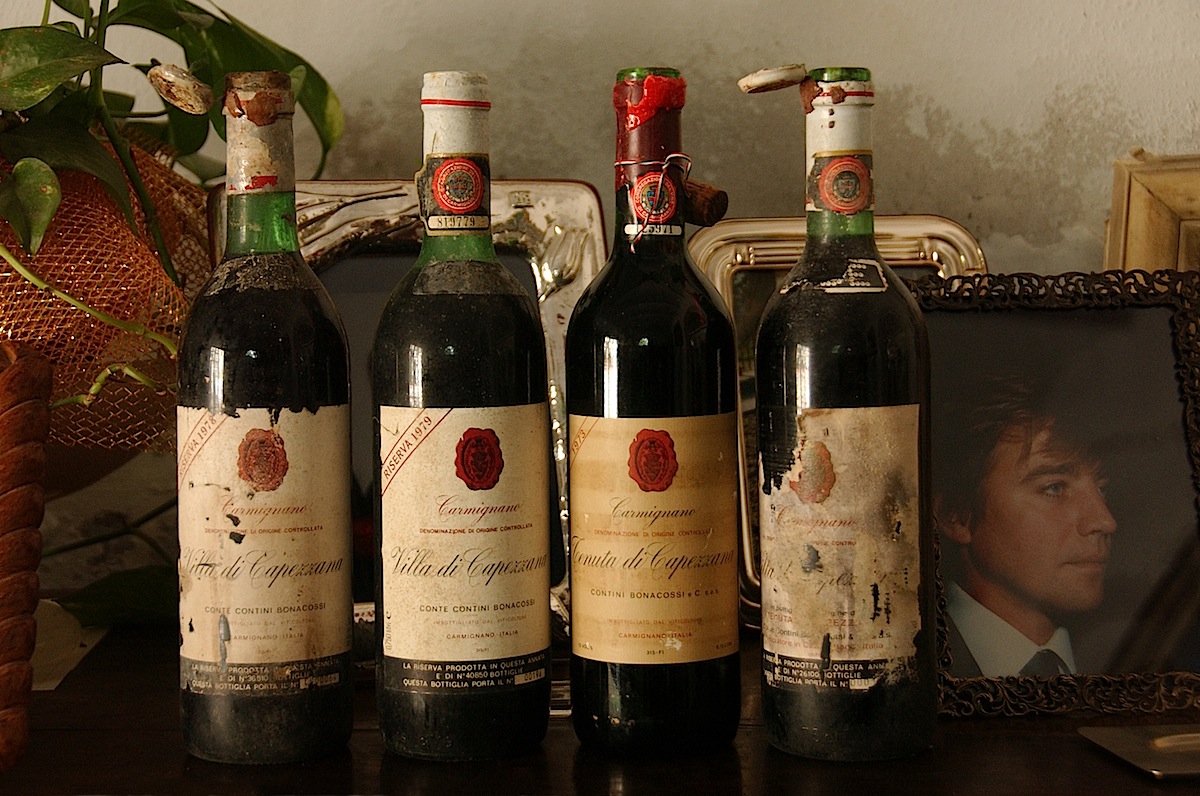
The driving force and ambassador
behind Capezzana now is Countess Beatrice Contini
Bonacossi, who, in person, prefers to be called simply
Bea. (In the family photo above, she is just to the left
of the open door.) I met her for lunch in New York and
we spoke about the advances being made in Tuscany and at
her family’s estate. “As we four siblings are now in
charge of all key areas, we take a holistic view and
hands-on approach to management,” she said. “We agree to
disagree, but we all see the future as evolutionary
versus revolutionary.” Her sister Benedetta is the
winemaker, her brother Vittorio in charge of the
vineyards, and Filippo handles the finances and the
company’s olive oil business.
They also run tours of the
property, with its 16th century wine cellars, and you
may even rent one of their historic villas there. And,
if you’re in Florence, nearly half their vast art
collection is on view at the Uffizi Gallery.
Still, says Bea, “We are always
conscious of the cost of our wines, and our sales rise
because we do not price ourselves out of the market for
Italian wines.” Evidence of this intent is their
$12 Monna Nera 2012, a wine “for young people,” light,
fruity, with a little peppery bite. So, too, the
$15 Barco Reale 2010, which is 70 percent sangiovese, is
called a “baby carmignano,” and is delectable as an
every day red wine.
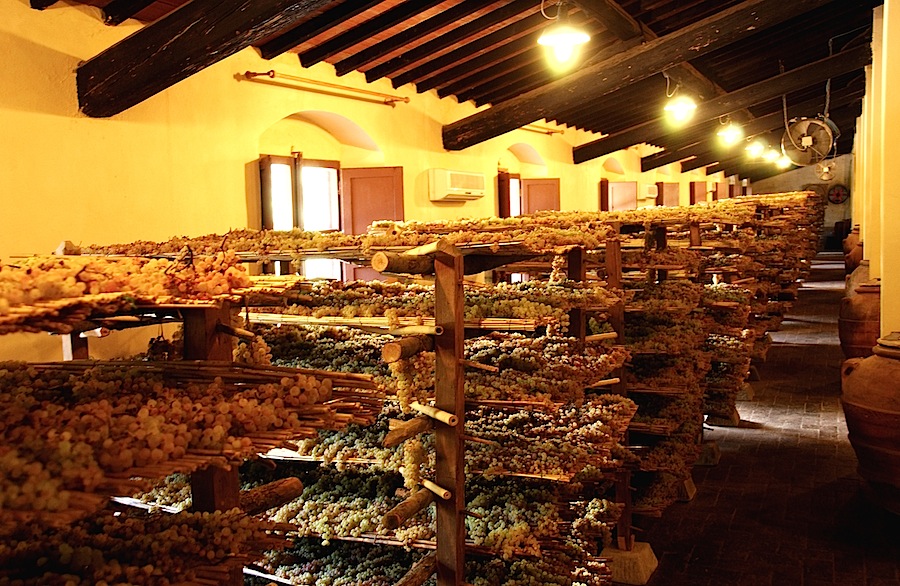 As
the wines move up in price, style, finesse and
complexity come into play, as in the superb single
vineyard blend Ghiale della Furbia 2007 ($55), made from
60 percent cabernet, 30 percent merlot for softness, and
a sprightly 10 percent syrah. The vineyard was planted
with cuttings taken by Bea’s father from the
Lafite-Rothschild estate.
As
the wines move up in price, style, finesse and
complexity come into play, as in the superb single
vineyard blend Ghiale della Furbia 2007 ($55), made from
60 percent cabernet, 30 percent merlot for softness, and
a sprightly 10 percent syrah. The vineyard was planted
with cuttings taken by Bea’s father from the
Lafite-Rothschild estate.
We went through a vertical
sampling of Villa de Capezzana carmignanos, beginning
with a 2008 vintage ($30) with an exceptionally high
14.5 percent alcohol, due, said Bea, “to changes in the
climate we have noticed since 2000. We left the grapes
on the vines longer to perfect them.”
The 1998 ($150) reflected an
earlier, cooler climate, with 13.3 percent alcohol,
albeit after a very hot summer. The 1988 had honey notes
and well-tamed tannins, but I would not expect this
vintage to last much longer, and at $280, if you can
find it, a bit of a risk.
Oddly enough, a rare 1968
Riserva ($600), made from 65 percent sangiovese, 10
percent cabernet, 15 percent canaiolo and 10 percent
“complementary grapes” tasted fresher than the 1988,
though it was curiously thin, perhaps reflecting
carmignano’s lighter body in those days.
By the way, Capezzana also makes a
superb vin santo, produced by allowing the grapes to "bake"
in the upper room of the winery (left) till they become
raisin-like and to produce a rich, viscous sweet wine
they call Vinsantia. But times have
changed and carmignano seems poised to take its rightful
place among the best DOCG wines in Italy. With the
U.S. Capezzana’s largest importer and China now second,
the family’s challenge will be to produce enough wine to
satisfy the market but only enough carmignano to sustain
its eminence.
❖❖❖
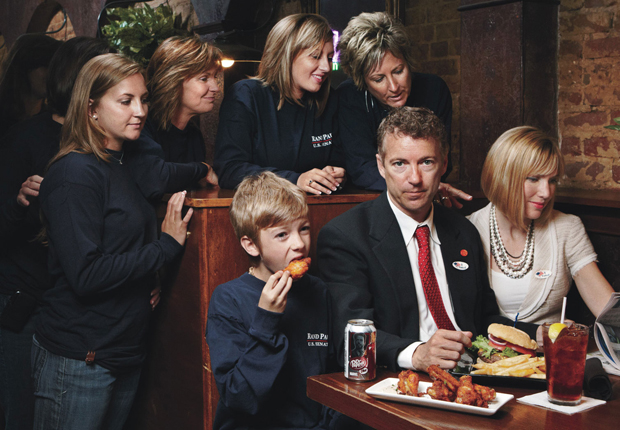
Sen. Rand
Paul warned the citizenry that the federal
government is now targeting doughnuts take-over.
"They're coming after your doughnuts!" he said of the
FDA's decision to ban trans fats. Paul also
insisted that the employees of the agency should
be forced to get healthy themselves. "I say we
should line every one of them up. I want to see how
skinny or how fat the FDA agents are that are making the
rules on this," Paul said.
 OY
VEY!
OY
VEY!❖❖❖
Any of John Mariani's
books below may be ordered from amazon.com.
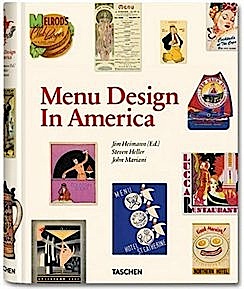 |
My latest book, which just won the prize for best book from International Gourmand, written with Jim Heimann and Steven Heller, Menu Design in America, 1850-1985 (Taschen Books), has just appeared, with nearly 1,000 beautiful, historic, hilarious, sometimes shocking menus dating back to before the Civil War and going through the Gilded Age, the Jazz Age, the Depression, the nightclub era of the 1930s and 1940s, the Space Age era, and the age when menus were a form of advertising in innovative explosions of color and modern design. The book is a chronicle of changing tastes and mores and says as much about America as about its food and drink.
“Luxuriating vicariously in the pleasures of this book. . . you can’t help but become hungry. . .for the food of course, but also for something more: the bygone days of our country’s splendidly rich and complex past. Epicureans of both good food and artful design will do well to make it their coffee table’s main course.”—Chip Kidd, Wall Street Journal.
“[The menus] reflect the amazing craftsmanship that many restaurants applied to their bills of fare, and suggest that today’s restaurateurs could learn a lot from their predecessors.”—Rebecca Marx, The Village Voice. |
"Eating Italian will never be the same after reading John Mariani's entertaining and savory gastronomical history of the cuisine of Italy and how it won over appetites worldwide. . . . This book is such a tasteful narrative that it will literally make you hungry for Italian food and arouse your appetite for gastronomical history."--Don Oldenburg, USA Today. "Italian
restaurants--some good, some glitzy--far
outnumber their French rivals. Many of
these establishments are zestfully described
in How Italian Food Conquered the World, an
entertaining and fact-filled chronicle by
food-and-wine correspondent John F.
Mariani."--Aram Bakshian Jr., Wall Street
Journal.
"Equal parts
history, sociology, gastronomy, and just
plain fun, How Italian Food Conquered the
World tells the captivating and delicious
story of the (let's face it) everybody's
favorite cuisine with clarity, verve and
more than one surprise."--Colman Andrews,
editorial director of The Daily
Meal.com. "A fantastic and fascinating
read, covering everything from the influence
of Venice's spice trade to the impact of
Italian immigrants in America and the
evolution of alta cucina. This book will
serve as a terrific resource to anyone
interested in the real story of Italian
food."--Mary Ann Esposito, host of PBS-TV's
Ciao
Italia. "John Mariani has written the
definitive history of how Italians won their
way into our hearts, minds, and
stomachs. It's a story of pleasure over
pomp and taste over technique."--Danny Meyer,
owner of NYC restaurants Union Square Cafe,
Gotham Bar & Grill, The Modern, and
Maialino.
|
 |
 |
 |
 |
 |
 |
 |
 |
 Everett Potter's Travel Report:
Everett Potter's Travel Report: 
 Eating Las Vegas
is the new on-line site for Virtual Gourmet
contributor John A. Curtas., who since 1995
has been commenting on the Las Vegas food
scene and reviewing restaurants for Nevada
Public Radio. He is also the
restaurant critic for KLAS TV, Channel 8 in
Las Vegas, and his past reviews can be
accessed at KNPR.org.
Click on the logo below to go directly to
his site.
Eating Las Vegas
is the new on-line site for Virtual Gourmet
contributor John A. Curtas., who since 1995
has been commenting on the Las Vegas food
scene and reviewing restaurants for Nevada
Public Radio. He is also the
restaurant critic for KLAS TV, Channel 8 in
Las Vegas, and his past reviews can be
accessed at KNPR.org.
Click on the logo below to go directly to
his site.

Tennis Resorts Online: A Critical Guide to the World's Best Tennis Resorts and Tennis Camps, published by ROGER COX, who has spent more than two decades writing about tennis travel, including a 17-year stretch for Tennis magazine. He has also written for Arthur Frommer's Budget Travel, New York Magazine, Travel & Leisure, Esquire, Money, USTA Magazine, Men's Journal, and The Robb Report. He has authored two books-The World's Best Tennis Vacations (Stephen Greene Press/Viking Penguin, 1990) and The Best Places to Stay in the Rockies (Houghton Mifflin, 1992 & 1994), and the Melbourne (Australia) chapter to the Wall Street Journal Business Guide to Cities of the Pacific Rim (Fodor's Travel Guides, 1991).


MARIANI'S VIRTUAL GOURMET
NEWSLETTER is published weekly. Editor/Publisher: John
Mariani.
Contributing Writers: Christopher Mariani, Robert Mariani,
John A. Curtas, Edward Brivio, Mort Hochstein,
Suzanne Wright, and Brian Freedman. Contributing
Photographers: Galina Stepanoff-Dargery,
Bobby Pirillo. Technical Advisor: Gerry McLoughlin.
© copyright John Mariani 2013
